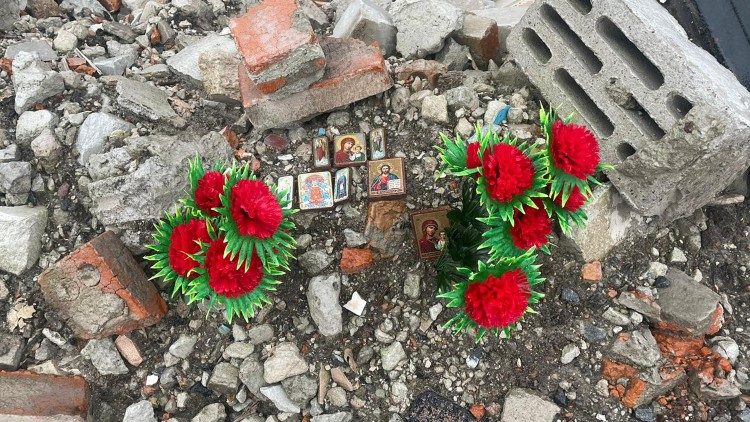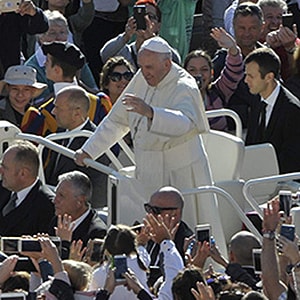
Izyum: A journey through the hell of Ukraine's war
By Salvatore Cernuzio – Izyum, Ukraine
"Tell everyone: war sucks." The raw words pronounced by an old woman wandering through the streets of Izyum with a fur coat and cane are probably the only possible commentary before the great mystery of evil done by one person to another.
That evil also takes the form of ropes used for torture, and the 15 square meters of underground rooms in which to lock up to eight people and force them to excrete in a sink. It also has the form of landmines placed under the 447 corpses buried in a mass grave to prevent relatives from removing the bodies.
If the brutality of the conflict in Ukraine has a name, it is Izyum. "A concentration of war crimes about which international human rights organizations are conducting in-depth investigations," military and civilian authorities clarify to journalists on a mission with the Polish and Ukrainian Embassies to the Holy See.
Theater of devastation
Situated in the southeast of Ukraine, on the Donets River, with temperature below 4 degrees Celsius, Izyum, occupied early March and liberated on 10 September, has become the scene of torture, devastation, and deportations.
The city is only two hours from Kharkiv, another center sadly famous for the explosion of one of Europe's largest markets. Unlike Kharkiv, however, where reconstruction has taken place in a short time and where people can be seen going to Church and stores, in Izyum the wounds of war are still evident.
It is not just blackened and gutted apartment buildings, chasms created by missiles in the streets, or even houses of which only the facade remains. The horror of war is in the details.
Like the jacket and shirt hanging from a closet from the third floor of a building on Vul Pershotravneva, split in two by a rocket in the 3-6 May bombings. Or like children's stuffed animals and toys lying in the mud or even photos of a couple on their wedding day peeking out from the rubble of the building across the street. It was actually one large construction with typical Soviet architecture that the missile split into two stumps.
Bombing
From the doorway on the right side emerges a woman with a shopping cart. She may have retrieved her own items, but it is more likely that she took out of necessity something left among the dust and soil. Perhaps one of the coats still stored in the smoke-blackened rooms.
"Who knows whose they were," one wonders. Just as one is left looking at the sachet of medicine next to a glass of water, wondering if the man or woman who had opened it made it in time to ingest it before the missiles plunged into the building.
Who knows who was playing on the slide at the playground across the street. Perhaps the two children who died in the blast: "One was eight, the other three," a policeman explains. Old enough to play alone, too young to die with 51 other people. "They were found under the rubble."
Captivity
More lifeless bodies were found in the city center, in the basement of the old police headquarters decommissioned after the renovation of the new station. The building remained serviceable and Russian soldiers appropriated it during the occupation, as can be seen from the blue Cyrillic lettering and the row of safes used as barricades, with bricks and sandbags.
The interior is so dark that it clouds each of the five senses. Except the sense of smell, immediately undermined by a strong smell of sewage, mold and stagnant smoke. Ropes and electrical wires hang from the ceiling, glass shatters and packs of Marlboros are crushed under boots. The central corridor leads to the basement. "Here," explains local police chief Dmytro Hranchak, "is where they kept the prisoners.
Tortures
Eleven rooms with rust-colored iron doors, a hundred inmates, seven or eight per room sharing two beds and the sink used as a toilet. Inside you can find blankets, boots, a windbreaker, a pair of underwear hanging on the wall. Then books, watches, canisters with yellow water.
They were all civilians but also military prisoners, confirms War Crimes prosecutor Mykola Pemenziev: "There is evidence of six women being raped."
Further down one room has walls lined with egg cartons. They were for soundproofing. "Katuvannya!" the guides exclaim. "Torture," to get information from relatives of soldiers at the front, reported on specific lists. Some resisted, some talked, some died.
Mass graves
Some corpses were left in the basement, the rest, along with victims of bombings and military actions, transported 14 minutes outside Izyum to Shakespeare Street where the town cemetery stands.
There, one walks on a muck from which stand wooden crosses, Catholic and Orthodox. Until September, 447 bodies were buried under that ground: 425 civilians, 22 soldiers. Now the ground has been de-mined and the bodies removed.
Turning around one notices open coffins, engraved names, little pictures and a few photos. Like that of Natasha, 87. Some crosses instead bear only numbers: 369, 125... These are the unnamed whose bodies have not been identified, in some cases because they are too disfigured, authorities explain.
Rebuilding quickly
"War sucks." The woman's words resonate in one's head. And they join those of Roman Semeukha, deputy head of the regional military administration, about the urgency of "having material for floors, windows, roofs. We need to rebuild quickly because we hope that in the spring the people who left will be able to return." We are talking about 25,000 residents who fled, out of 50,000 before the attack.
The Cossack mural
From the central square, amid the snow and ice on the sidewalks, you catch a glimpse of an image that is out of context and yet somehow gives hope. On the right wall of what used to be the mayor's office, two boys on a hoist are painting a mural.
Their artwork depicts the "Cossack", a cartoon character popular with Ukrainian children in the 1960s and 1970s. It depicts a legendary hero from the 15th-16th centuries. The gesture is symbolic: before the buildings, in Izyum one wants to rebuild the nation's mascot. One wants to reconstruct Ukraine's identity.
Thank you for reading our article. You can keep up-to-date by subscribing to our daily newsletter. Just click here









